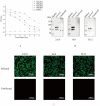Identification of B-Cell Epitopes Located on the Surface of the S1 Protein of Infectious Bronchitis Virus M41 Strains
- PMID: 40284907
- PMCID: PMC12031124
- DOI: 10.3390/v17040464
Identification of B-Cell Epitopes Located on the Surface of the S1 Protein of Infectious Bronchitis Virus M41 Strains
Abstract
Avian infectious bronchitis is caused by the avian infectious bronchitis virus (IBV), which poses a significant threat to the poultry industry and public health. The S1 protein of IBV plays a crucial role in the process of the virus invading host cells. To investigate the significant antigenic targets within the S1 protein, in this study, the truncated S1 sequence of the IBV M41 strain was cloned with approximately 660 bp and expressed. After purification and renaturation, the recombinant S1 protein was immunized into BALB/c mice. Then, following fusion with lymphocytes and SP2/0 cells, the indirect ELISA and Western blotting techniques were employed to screen hybridoma cell lines secreting monoclonal antibodies (mAbs) targeting the S1 protein. Antigenic epitopes of the mAbs were identified using truncated S1 fragments and peptide scanning. The results indicated that three hybridoma cell lines stably secreting S1 protein-specific mAbs (2A10, 4E9, and 5E12) were screened. The heavy chains of the three mAbs were IgG1, and all three mAbs contained kappa light chains. The identified minimal B-cell epitopes were 132RVSAMK137 and 142FYNLTV147. Homology analysis showed these both epitopes were conserved across IBV subtypes and located on the S1 protein surface. The conserved β-sheet epitope 132RVSAMK137 and the surface-exposed, flexible loop epitope 142FYNLTV147 serve as ideal targets for broad-spectrum diagnostics and early infection detection, respectively. These epitopes provide unique structural advantages for antibody binding, enabling the design of multivalent epitope vaccines or the development of immunomodulatory drugs. They offer novel biomaterials and targets for antibody-based drug development and rapid detection methods for avian infectious bronchitis virus (IBV), holding significant potential for the prevention and control of IBV.
Keywords: B-cell epitope; S1 antigenic determinants; avian infectious bronchitis virus; monoclonal antibody; overlapping fragments; peptide scanning; prokaryotic expression.
Conflict of interest statement
The authors declare no conflicts of interest.
Figures





Similar articles
-
Two novel neutralizing antigenic epitopes of the s1 subunit protein of a QX-like avian infectious bronchitis virus strain Sczy3 as revealed using a phage display peptide library.Vet Immunol Immunopathol. 2015 Nov 15;168(1-2):49-55. doi: 10.1016/j.vetimm.2015.08.008. Epub 2015 Aug 19. Vet Immunol Immunopathol. 2015. PMID: 26315775 Free PMC article.
-
Isolation, molecular identification, and phylogenetic analysis of infectious bronchitis virus from commercial chicken farms in Mekele and Bishoftu, Ethiopia, 2023-2024.Virol J. 2025 Apr 2;22(1):90. doi: 10.1186/s12985-025-02639-4. Virol J. 2025. PMID: 40176128 Free PMC article.
-
Development and characterization of neutralizing monoclonal antibodies against the S1 subunit protein of QX-like avian infectious bronchitis virus strain Sczy3.Monoclon Antib Immunodiagn Immunother. 2015 Feb;34(1):17-24. doi: 10.1089/mab.2014.0081. Monoclon Antib Immunodiagn Immunother. 2015. PMID: 25723279 Free PMC article.
-
Severe acute respiratory syndrome vaccine development: experiences of vaccination against avian infectious bronchitis coronavirus.Avian Pathol. 2003 Dec;32(6):567-82. doi: 10.1080/03079450310001621198. Avian Pathol. 2003. PMID: 14676007 Free PMC article. Review.
-
SARS-CoV-2-neutralising monoclonal antibodies to prevent COVID-19.Cochrane Database Syst Rev. 2022 Jun 17;6(6):CD014945. doi: 10.1002/14651858.CD014945.pub2. Cochrane Database Syst Rev. 2022. PMID: 35713300 Free PMC article.
Cited by
-
Thirty-Five Years of IBV Evolution in Chile Reveals a Novel Lineage and Evidence of Vaccine-Driven Recombination.Viruses. 2025 Aug 13;17(8):1111. doi: 10.3390/v17081111. Viruses. 2025. PMID: 40872824 Free PMC article.
References
-
- Cavanagh D. Coronavirus avian infectious bronchitis virus. Vet. Res. 2007;38:281–297. - PubMed
-
- Andreychev A., Boyarova E., Brandler O., Tukhbatullin A., Kapustina S. Terrestrial and subterranean mammals as reservoirsof zoonotic diseases in the central part of European Russia. Diversity. 2023;15:39.
-
- Schalk A.F., Hawn M.C. An apparently new respiratory disease of baby chicks. J. Am. Vet. Med. Assoc. 1931;78:19.
-
- Beach J.R., Schalm O.W. A filterable virus, distinct from that of laryngotracheitis, the cause of a respiratory disease of chicks. Poult. Sci. 1936;15:199–206.
Publication types
MeSH terms
Substances
Grants and funding
LinkOut - more resources
Full Text Sources

